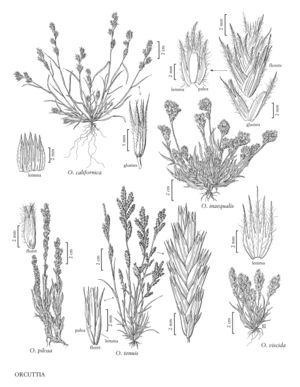Difference between revisions of "Orcuttia viscida"
FNA>Volume Importer |
FNA>Volume Importer |
||
| Line 13: | Line 13: | ||
}}<!-- | }}<!-- | ||
| − | --><span class="statement" id="st-undefined" data-properties=""><b>Plants </b>pilose, very viscid, strongly aromatic. <b>Culms</b> 3-10(15) cm, simple, erect, often spreading in age. <b>Leaves</b> usually without a "collar" line; blades 2-4 mm wide. <b>Spikes</b> 3-5 cm, somewhat congested (less so than those of O. inaequalis); lower and upper internodes 3-7 mm. <b>Spikelets</b> with 6-20(30) florets. <b>Glumes</b> subequal, 5-6 mm, unequally 3-toothed, teeth as long as the bodies, awn-tipped; lemmas 6-7 mm, teeth as long as the lemma bodies, central tooth evidently the longest, awns at least 1 mm; paleas at least 3/4 as long as the lemmas; anthers about 2 mm. <b>Caryopses</b> 2.3-2.5 mm, broadly elliptical; embryos about as long as the caryopses. <b>2n</b> = 28.</span><!-- | + | --><span class="statement" id="st-undefined" data-properties=""><b>Plants </b>pilose, very viscid, strongly aromatic. <b>Culms</b> 3-10(15) cm, simple, erect, often spreading in age. <b>Leaves</b> usually without a "collar" line; blades 2-4 mm wide. <b>Spikes</b> 3-5 cm, somewhat congested (less so than those of <i>O. inaequalis</i>); lower and upper internodes 3-7 mm. <b>Spikelets</b> with 6-20(30) florets. <b>Glumes</b> subequal, 5-6 mm, unequally 3-toothed, teeth as long as the bodies, awn-tipped; lemmas 6-7 mm, teeth as long as the lemma bodies, central tooth evidently the longest, awns at least 1 mm; paleas at least 3/4 as long as the lemmas; anthers about 2 mm. <b>Caryopses</b> 2.3-2.5 mm, broadly elliptical; embryos about as long as the caryopses. <b>2n</b> = 28.</span><!-- |
-->{{Treatment/Body | -->{{Treatment/Body | ||
|distribution=Calif. | |distribution=Calif. | ||
| − | |discussion=<p>Orcuttia viscida grows at elevations below 120 m in Sacramento County, California. Its awn-tipped lemma teeth curve outward at maturity, giving the spikes a distinctive, bristly appearance. It is listed as an endangered species by the U.S. Fish and Wildlife Service.</p> | + | |discussion=<p><i>Orcuttia viscida</i> grows at elevations below 120 m in Sacramento County, California. Its awn-tipped lemma teeth curve outward at maturity, giving the spikes a distinctive, bristly appearance. It is listed as an endangered species by the U.S. Fish and Wildlife Service.</p> |
|tables= | |tables= | ||
|references= | |references= | ||
| Line 38: | Line 38: | ||
|publication year= | |publication year= | ||
|special status= | |special status= | ||
| − | |source xml=https://jpend@bitbucket.org/aafc-mbb/fna-data-curation.git/src/ | + | |source xml=https://jpend@bitbucket.org/aafc-mbb/fna-data-curation.git/src/8f726806613d60c220dc4493de13607dd3150896/coarse_grained_fna_xml/V25/V25_472.xml |
|subfamily=Poaceae subfam. Chloridoideae | |subfamily=Poaceae subfam. Chloridoideae | ||
|tribe=Poaceae tribe Orcuttieae | |tribe=Poaceae tribe Orcuttieae | ||
Revision as of 16:33, 18 September 2019
Plants pilose, very viscid, strongly aromatic. Culms 3-10(15) cm, simple, erect, often spreading in age. Leaves usually without a "collar" line; blades 2-4 mm wide. Spikes 3-5 cm, somewhat congested (less so than those of O. inaequalis); lower and upper internodes 3-7 mm. Spikelets with 6-20(30) florets. Glumes subequal, 5-6 mm, unequally 3-toothed, teeth as long as the bodies, awn-tipped; lemmas 6-7 mm, teeth as long as the lemma bodies, central tooth evidently the longest, awns at least 1 mm; paleas at least 3/4 as long as the lemmas; anthers about 2 mm. Caryopses 2.3-2.5 mm, broadly elliptical; embryos about as long as the caryopses. 2n = 28.
Discussion
Orcuttia viscida grows at elevations below 120 m in Sacramento County, California. Its awn-tipped lemma teeth curve outward at maturity, giving the spikes a distinctive, bristly appearance. It is listed as an endangered species by the U.S. Fish and Wildlife Service.
Selected References
None.
